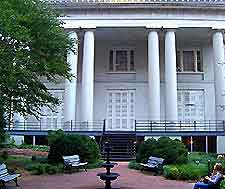Richmond History Facts and Timeline
(Richmond, Virginia - VA, USA)

Richmond, Virginia, is considered to be one of the USA's oldest cities. The city's history dates back to the early 1600s, when King James I gave the London Company permission to build English-speaking settlements in this area.
The settlement that eventually became Richmond was the second to be established by the company, being located on land that had been occupied by Native American tribes for many years. The community was set on the banks of the River James, a spot that is now popular for outdoor recreation.
The American Revolution
William Byrd II, a planter, played a large part in the early history of the town. He oversaw the laying out of the initial town grid and named the town Richmond in 1737. He likened the vista of the River James to the panorama of London's Thames River, when witnessed from Richmond Hill.
The city grew quickly and became a bustling center for both the slave trade and the fight for independence from the British. In 1780, Richmond became the state capital, since the former capital,
Williamsburg, had come under an increasing number of British attacks. This attempt to protect Virginia's capital was unsuccessful however, as British forces set fire to the city in 1781.
By the following year, Richmond had recovered to become a flourishing city once more. The Thomas Jefferson-designed Virginia State Capitol building was finished in 1788 and remains among the chief historical attractions to this day.
The American Civil War History
In the years following the American Revolution, Richmond became a thriving manufacturing center, with flour mills and ironworks being the most prominent industries. Shipping also became crucial to the local economy after the opening of the James River and Kanawha Canal.
In April 1861, Virginia seceded from the US and by May, it had joined the Confederacy. Richmond soon became the Confederate capital and the Confederate Congress began to meet in an elegant mansion known as the White House of the Confederacy. The mansion has now been restored and offers guided tours, which are operated by the Museum of the Confederacy. The museum is located within the historic Museum District and hosts one of the biggest collections of Confederate photographs and records in the country.
The fact that Richmond hosted the Tredegar Iron Works was a key reason why the city was chosen as the Confederate capital. The iron works produced much of the Confederate artillery, as well as a huge amount of armor plating. It is nowadays home to the American Civil War Center and the National Battlefield Headquarters at Tredegar.
Union forces came close to taking Richmond in 1862, but only managed to defeat Confederate forces in 1865. Much of the city was destroyed after Confederate forces burned the city whilst they retreated.
Jackson Ward
In the wake of the Civil War, Richmond recovered to become one of the country's economic powerhouses. This was due in no small part to the emergence of the railways and a streetcar system that served the city. At this time one of the first African-American districts, Jackson Ward, was established. This district was home to an early African-American bank and was known to many as the 'Wall Street of Black America'.
Shockhoe Bottom
Jackson Ward is located in the city center, where Shockhoe Bottom can also be found. While the development of Jackson Ward is something that the city can be proud of, Shockhoe Bottom leaves a black mark on Richmond history. Although now a thriving entertainment district, it was once the city's slave center. Before the start of the American Civil War, more than 300,000 slaves are believed to have passed through Shockhoe Bottom on their way to the Deep South.
The Downtown Boom
The 1960s saw a development boom in downtown Richmond, which included the construction of the Virginia Commonwealth University. The city expanded to incorporate Chesterfield County in 1970 and the business-orientated River District grew. This part of the city now boasts the Canal Walk, as well as a precinct for diners and night owls.
 Richmond, Virginia, is considered to be one of the USA's oldest cities. The city's history dates back to the early 1600s, when King James I gave the London Company permission to build English-speaking settlements in this area.
Richmond, Virginia, is considered to be one of the USA's oldest cities. The city's history dates back to the early 1600s, when King James I gave the London Company permission to build English-speaking settlements in this area.